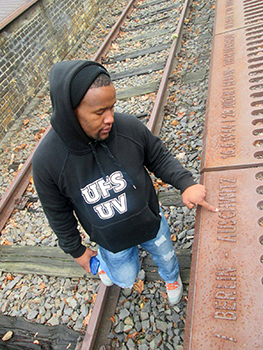Student leaders reflect on post-Holocaust Germany and make connections to post-apartheid SA in study tour

Njabulo Mabaso
Photo: Sam Styrax |
“Our beloved South Africa (SA) has done quite a lot insofar as policy formulation to address the past imbalances is concerned. However, implementation has proven to be the biggest challenge.”
This is the view held by Nkosinathi Tshabalala, former Student Representative Council (SRC): Religious Affairs at Qwaqwa Campus of the University of the Free State (UFS), who was part of the Global Leadership Study Tour.
From 14 - 22 November 2015, a cohort of 37 outgoing SRC members studied through tours and seminars in Germany and Poland. The historical education trip was organised jointly by UFS Rector and Vice-Chancellor, Prof Jonathan Jansen, and the Student Affairs office. The study tour was supported and facilitated by the Johannesburg Holocaust and Genocide Centre.
Tshabalala added: “We know the thinking behind the likes of Reconstruction and Development Programme and the Truth and Reconciliation Commission, to mention only two. But what have these done to close the gap between the rich and the poor? What have they done to encourage proper and complete reconciliation? Germany paid for the damages which came as a result of the Holocaust, and it is time that we do the same.”
Mosa Leteane, former SRC President of the Bloemfontein Campus, echoed Tshabalala’s sentiments as they relate to the SA experience. “In light of the Rhodes Must Fall movement, one of the things that the youth was looking at were the symbols, what symbols mean, how symbols works as part of reparation and redress in a country that has come from a tragic past,” she said.
Leteane identified similarities between how our country and the two European nations have confronted the issue of trans-generational trauma and the reconciliation process, albeit in significantly differing circumstances.
“Within the first 20 years or so, it was almost like SA. Nobody wanted to talk about it, people just wanted to build the country.” Nonetheless, “the memorialisation and commemoration happened only for the last 20 years or so,” added Leteane.
Transformation of the European political, environmental, and social landscape took place only when students and the second generation began to challenge the status quo, and to lobby for transformation through the erection of memorials and monuments. Owing to the courage of the young generation, those countries were able to take meaningful steps towards transformation through an accurate narration and commemoration of history, which is a key factor in reconciliation.
Our students had the opportunity to conduct a comparative study of post-Holocaust Germany and post-apartheid South Africa in terms of how government and universities dealt with trans-generational trauma.
By being exposed to remnants of what used to be sites such as the Auschwitz-Birkenau concentration camp memorial in Poland, the young leaders were encouraged to continue their attempt at nation building and advance transformation and reconciliation.